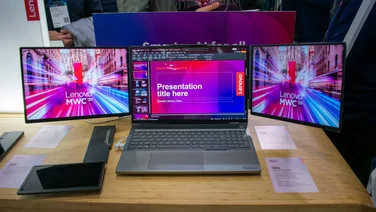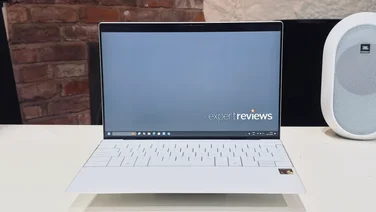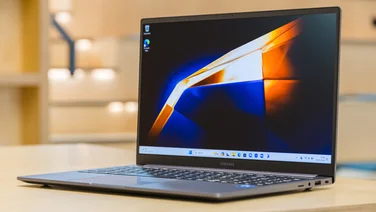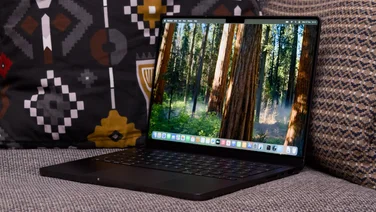To help us provide you with free impartial advice, we may earn a commission if you buy through links on our site. Learn more

- Insanely fast and powerful
- Exquisite build
- Slick 120Hz screen
- Very expensive
- Quite chunky
If you lined up all the new gaming laptops Asus released in 2021, they would stretch to the moon. Or that’s what it feels like: Asus assures me that the actual number of new models is 11. Just in the four months preceding the release of the ROG Zephyrus S17 GX703, we saw the dual-screen ROG Zephyrus Duo 15, the £1,600 TUF Gaming A15 and the power-packed ROG Strix Scar 17. And then came this 17in monster.
Although “monster” is the wrong word to describe the Zephyrus S17 GX703. This is a classy laptop that just happens to be packed with the latest gaming components; call it big-boned rather than corpulent, limboing 0.1mm under the 20mm bar.
It’s formidable, however, weighing 2.6kg and stretching almost 40cm across. Even its power supply weighs a shade over 1kg, which isn’t a surprise when it outputs up to 280W. With a 90Wh battery, the S17 lasted for 8hrs 32mins in our lightweight video-rundown test, but portability still isn’t one of this laptop’s strengths.
Asus ROG Zephyrus S17 GX703 review: Performance
Instead, its strength is power. Asus sent in its top-of-the-range model (GX703HS-KF004R) for testing, and that means Nvidia’s 140W version of the mobile GeForce RTX 3080.
Asus backs that up with an Intel Core i9-11900H processor, which laughs in the face of power efficiency and focuses on packing astonishing levels of processing oomph. It sits at the top of Intel’s mobile range.
It doesn’t really matter what benchmark you turn to, this laptop sits at the top. Take Cinebench R23. Its single-core result of 1,577 is a healthy distance ahead of the next highest, but when you switch to that benchmark’s multicore component it destroys all-comers with a score of 13,356. Likewise a score of 371 in our benchmarks is pretty well unprecedented for a laptop, chewing through our tough multitasking test in 6.5 minutes.
It helps that Asus supports the processor with 32GB of RAM and a RAID0 array of PCI-E 4 SSDs (for a total 2TB of storage), and AS SSD returned 5,650MB/sec for reads and 4,374MB/ sec for writes. That’s so fast it’s a wonder the disks don’t melt.
READ NEXT: See how this compares to the best SSDs currently available
Asus ROG Zephyrus S17 GX703 review: Gaming
Then we come to gaming performance, and here, once again, you’ll struggle to find a test where this machine doesn’t top the charts.

What’s most crucial is that, in the vast majority of games, you can hit a comfortable 120fps at the screen’s native 1440p resolution without dialling down the settings. For example, in the demanding Shadow of the Tomb Raider it averaged 140fps at 1080p, dropping a fraction to 119fps with DLSS switched on at 1440p.
In Wolfenstein: Youngblood, with DLSS and ray tracing active, it managed 187fps at 1080p and 146fps at 1440p. Even Hitman 2 averaged 120fps at 1440p, once I’d turned super sampling from 2x to 1x (at 2x even this hardware can only manage 44fps).
Metro: Exodus proved the toughest challenge, with 85fps at 1440p and 111fps at 1080p. Still, all these results are at High settings, so if you reach the point where you want to increase your frame rates, you have leeway.
Asus ROG Zephyrus S17 GX703 review: Display
The reason I focus on 120fps is because this is a 120Hz screen. This provides visibly slicker motion in Windows 10, but naturally its biggest advantage is during games. At the risk of teaching gamers to suck Easter eggs, the difference between a game running smoothly at 120fps on a screen like this and one running on a standard 60Hz screen is night and day: everything feels more real.

It helps that Asus uses a top-quality IPS panel with superb colour coverage. It’s tuned to the DCI-P3 gamut, covering 99.5% of that space out of a 104% volume. Combine that with an average Delta E of 0.4 and you can be confident that the colours you’re seeing on the screen are exactly what games designers and film directors imagined.
If you’re a content creator, the only thing you can’t do on this laptop is create HDR content, as its maximum brightness is 310cd/m². With 84% Adobe RGB coverage (and great colour accuracy) it’s a competent choice for print designers. Download Nvidia’s Studio drivers and you gain support and faster results in professional software from firms such as Adobe, DaVinci and Redshift.
The ROG Zephyrus packs in a brilliant speaker system as well. Vocals come out so clearly it’s as if the singer was right next to you, while individual guitar strings are delivered in a way that most laptops can’t dream of; listening to the intro of “Caribou” by the Pixies was a revelation on the Zephyrus S17. There’s only one area of weakness and that’s an audible crackle when the speakers are pushed too far.
READ NEXT: These are the best external speakers to buy right now
Asus ROG Zephyrus S17 GX703 review: Keyboard
Asus pays equal attention to all other aspects of this laptop’s design. Not content with merely supplying a mechanical keyboard, it insists on giving it a 5° angle for greater comfort. I’m not too fussed by this, but I do love the click of each key and the obvious activation when you press down.

Asus includes a numberpad on the right, which means your hands are shifted to the left when typing. What’s more surprising is that Asus doesn’t create a gap between the pad and the main keyboard, so it may take a while for your muscle memory to know where the backspace key is, for example.
But I’m being picky here, as everything else about this keyboard is fantastic. The cursor keys have their own dedicated area, the Esc key sits alone, and the function keys are split into three groups of four to make them easier to hit at that crucial juncture. There’s full RGB backlighting, too.
The final button of note is the “multiwheel”, which sits above the F1 and F2 keys. At its most basic you can use this to adjust the speaker volume, but if you long-press on it then a wider set of options appear. You may want to let it control the display brightness, say, or the backlighting. It won’t change your life, but it’s a handy extra.
READ NEXT: Check out our favourite mechanical and membrane keyboards for gaming
Asus ROG Zephyrus S17 GX703 review: Asus software
To take fine control of things such as the RGB colour scheme, you must head to Asus’ Armoury Crate app. Not that this laptop boasts any RGB lighting beyond the keyboard; if you want strip lights down the side, look to Asus’ ROG Strix Scar range instead.
In fact, the design of the Zephyrus S17 is positively demure next to many gaming laptops, with black metal the order of the day. Even the ROG logo on the lid is subtle, finished in gloss against the matte finish of the rest of the body. If you look closely, you’ll also spot “REPUBLIC OF GAMERS” lettering along a subtle line that cuts diagonally across the lid, with tiny dots below, but the only thing that would make me feel uncomfortable about taking this laptop into a meeting is its sheer size.
Asus also packs in the ports. Two USB-A 3.2 connectors lie on the right-hand side, along with an SD card slot, while the left is home to an HDMI output, Gigabit Ethernet, USB-A 3.2 port, 3.5mm jack, plus a pair of USB-C ports: one supports Thunderbolt 4, the other USB 3.2. You also get support for Wi-Fi 6 and Bluetooth 5.2.
Asus ROG Zephyrus S17 GX703 review: Verdict
I haven’t talked about the price yet, but, like walking into a Mayfair shop, if you have to ask how much the Zephyrus S17 costs then you probably can’t afford it.
There are far cheaper gaming laptops, and you’re paying a premium not only for performance but also for quality. That includes the 1440p display, mechanical keyboard and high-quality chassis.
If you want more RGB bling and don’t mind a fatter design, the ROG Strix 17 G733 is a better choice. For us, though, the more subtle and slimmer Zephyrus design – and superior screen – win out. If money is no object, this is our gaming laptop of choice.
READ NEXT: Dell XPS 17 review






